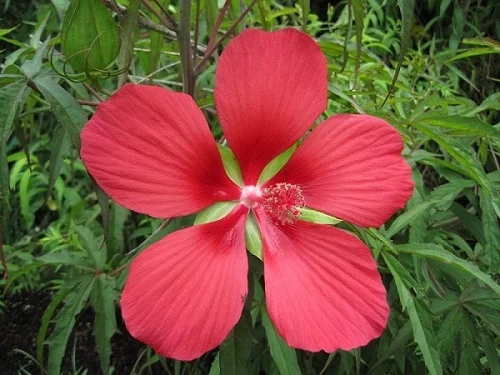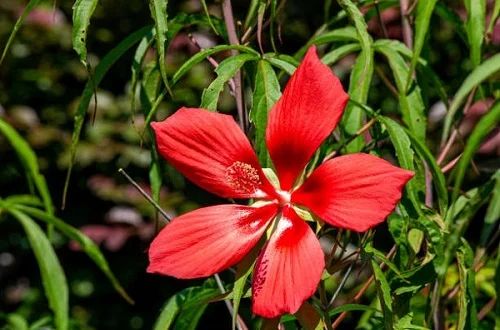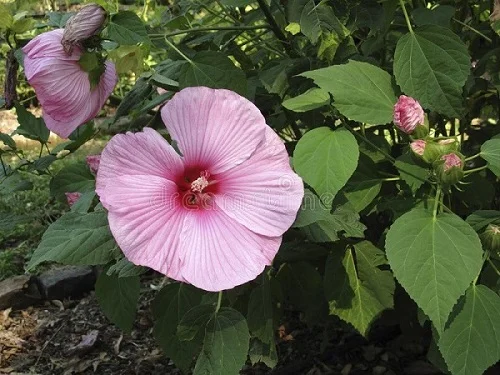How to Grow and Care for Scarlet Hibiscus | Hibiscus coccineus Care Guide
Some links in this post may be affiliate links
Scarlet Hibiscus (Hibiscus coccineus) or Scarlet Rosemallow is a herbaceous, perennial hibiscus which bears five-petalled bright scarlet flower and palmately compound leaves.
The leaves are thin, shiny, deep-green and about 5-6 inches wide. This characteristic causes it to look-like Cannabis sativa.
Though called Texas Star, it is not native to Texas but it is a common landscape plant in that area. It also has a white variety, called Hibiscus coccineus 'Alba' (White Texas Star or Lone Star Hibiscus).
Unlike the Tropical Hibiscus rosa-sinensis (Rose of China), Hibiscus coccineus is a cold-hardy Hibiscus which is ideal for USDA Zones 6-9. The foliage dies in winter but it comes back as the temperatures begin to warm up in spring.
Scarlet Rosemallow can be grown in containers in the colder regions where it can be brought inside in winter and placed in a brightly lit spot with 6-8 hours of sunshine per day.
The genus name, 'Hibiscus', is old Greek or Latin for 'mallow'. The species name, 'coccineus', is Latin for 'colored' or 'dyed scarlet', in reference to the brilliant flowers.

Photo Credit: Mellow Marsh Farm
Botanical name: Hibiscus coccineus
Family: Malvaceae
Common names: Scarlet Hibiscus, Scarlet Rosemallow, Texas Star Hibiscus, Brilliant Hibiscus, Wild Red Mallow, Crimson Red Mallow
Origin
Hibiscus coccineus is native to swamps and marshes in southerneastern North America (southeastern Virginia south to Florida then west to Louisiana).
Flowers
Scarlet Hibiscus flowers are about 5-6 inches wide, five-petalled, bright scarlet and look-like hollyhocks. They have a staminal column protruding from the center with creamy-yellow to pale-yellow stamens.
The flowers appear in late summer to early fall and each lasts for 1-3 days. The flowers are produced in succession with a flower being produced each day. They attract butterflies, humming birds, bees and other pollinators.
Size
Scarlet Hibiscus size ranges from 6-8 feet tall and 2-3 feet wide. They are fast growing plants which can grow to the maximum height in one year when grown in the right conditions.
Scarlet Hibiscus Care
Scarlet Hibiscus (Hibiscus coccineus) thrives in full sun with at least 6-8 hours of sunshine per day, hot and humid conditions, consistently moist, slightly acidic to slightly alkaline soil that is rich in organic matter.
Hibiscus coccineus requires annual cutting back to encourage new growth and promote flowering as well as control growth. Monthly feeding with a balanced slow release fertilizer during the growing season is recommended to promote growth and blooming. Keep reading for more on these growing conditions and how to achieve them.

Photo Credit: istock
Light Requirements
Scarlet Hibiscus requires full sun with at least 6-8 hours of sunshine per day through out the growing season. A sunny window with 6-8 hours of direct sunshine daily in winter is needed for the container-grown plants.
Avoid shaded conditions where the plant will be overshadowed by tall buildings, trees or other large plants as they require full sun for the growth of the flowers.
However, where the summers are very harsh, grow the plant in a shaded spot to protect it from the hot afternoon sunlight which can cause scorching of the leaves.
Water Requirements
Water Scarlet Hibiscus deeply and keep the soil consistently moist at all times during the growing season (spring to late fall). To achieve this, water deeply when the soil begins to dry out.
For container-grown Scarlet Rosemallow, ensure that the pot has a drainage hole and the soil is fast-draining to prevent the plant from sitting in soggy soil which can result in rotting and death of the plant.
Lessen watering in the cold period as growth is reduced at this time, thus, the plant does not need much water for growth but do not allow the soil to dry out.
Temperature and Humidity
Scarlet Hibiscus tolerant of hot and humid conditions and is not suited for areas where the winter temperatures are below -300C. In its hardiness zones, the plant goes into dormancy in winter.
To keep the soil warm in winter, apply a mulch of dry vegetation on the soil surface but take care not to let the mulch come into contact with the stem to prevent rotting.
Container-grown plants should be brought indoors when the temperatures dip to 00C and positioned in a brightly lit spot. They should be provided with adequate humidity as they cannot tolerate dry air.
Fertilizer
Scarlet Hibiscus needs monthly feeding during the growing season to promote healthy growth and blooming. Feed it with a balanced, slow-release fertilizer but withhold feeding in the cold season to avoid fertilizer burn.
Soil
Scarlet Rosemallow is tolerant of a wide range of soils; sandy, loamy or clay and can cope with wet soils. The best soil for Scarlet Hibiscus should be moist, slightly acidic to slightly alkaline and rich in organic matter.
Any soil that is low in organic matter should be ammended. The soil should be able to hold adequate moisture as the plants require consistently moist soil to mimic their natural habitat.
Where to Buy Scarlet Hibiscus
Scarlet Hibiscus Plants are available from Garden Centres at the beginning of spring. You may obtain the plants from Etsy (Link to Etsy).
When to Plant Scarlet Hibiscus in the Ground
The best time to plant Scarlet Hibiscus in the ground is in spring after the risk of frost has passed and the soil has warmed up.
Planting Scarlet Hibiscus in the Ground
Situate Scarlet Hibiscus in a sheltered spot away from strong, chilling, drying winds inorder for it to thrive and reward you with a profusion of its pretty flowers.
Dig up the soil to a depth of about 12 inches to loosen it and get rid of all the weeds and other debris from the soil. Make sure that the soil is rich in organic matter or incorporate it where it is deficient.
Prepare planting holes twice as large as the rootballs at a spacing of 2-3 ft. Incorporate a handful of fully decomposed organic manure per hole.
Plant the Texas Star Hibiscus at the same depth as they were in their pot. Firm the soil around the root ball lightly.
Deeply water the plants. Thereafter, water the plants when the soil begins to dry out during the growing season (spring to late fall) but decrease watering in the cold season.
Repotting Container-grown Scarlet Hibiscus
Where the conditions are not favourable for growing Scarlet Hibiscus in the ground like in areas with harsh winters, you can grow the plants in containers.
Doing so allows you to move the plants to sunny spots during summer for the much needed sunlight and indoors next to a sunny window when the conditions are harsh in winter.
Make sure that the container(s) or pot(s) has a drainage hole to prevent the soil from getting soggy to prevent root-rot and eventual loss of the plant(s). Ensure that the container is deep enough to accommodate the roots.
Slip the Texas Star Hibiscus out of its pot and place it in the center of the new pot at the same soil level as it was in the previous pot and back fill with fresh, rich, free-draining soil.
Do not fill the pot completely but allow a space of about 1 inch from the rim for watering purposes to avoid spillage.
Wet the soil thoroughly until water comes out through the drainage hole(s). Thereafter, water deeply during the growing season (spring to late fall) to keep the soil consistently moist. Reduce watering in the cold season (winter) but do not allow the soil to dry out.
Repot the Scarlet Rosemallow every 1-2 years at the beginning of the growing season (spring). Use a pot that is 2 sizes larger than the current one to provide adequate room for growth.
Pruning Scarlet Hibiscus
Pruning Scarlet Hibiscus involves cutting back the plants in spring by 1/2 to encourage new growth and blooming. Cutting back promotes new growth from which the flower buds emerge.
In climates where the Texas Star Hibiscus dieback in winter, cutback the plants to 3-4 inches above the ground in late fall or early spring. New growth will emerge from the root system in spring as the temperature warm up.
Cutting back the plant, encourages the growth of more compact bushes and more blooms. Deadhead the spent flower if seeds are not required to keep the plant neat and tidy and also discourage pest and disease infestations.
Propagation
Scarlet Hibiscus (Hibiscus coccineus) is easily propagated from stem cuttings at the beginning of the growing season (spring or early summer) when new growth has begun.
How to propagate Scarlet Hibiscus from stem cuttings
Take 3-5 inches stem cuttings from a healthy Scarlet Hibiscus by cutting just below a leaf node.
Strip off the leaves from the lower 2-3 inches of the stem and dip the lower end in a rooting hormone to hasten rooting.
Insert the cutting in moist, free-draining, rooting soil in a small pot (about 4 in. wide) and lightly firm the soil around the cutting.
Cover the set up with a clear plastic bag to create a greehouse effect (increase humidity and warmth) inorder to fasten rooting.
Place the set up in a well-lit, warm (about 150C) place away from direct sunlight to avoid cooking the plants.
Maintain the soil slightly moist until the stem cuttings have rooted. Rooting may take 6-8 weeks and is indicated by growth of new leaves.
Tug at the cuttings a little, any resistance indicates rooting has occurred. Once rooted, remove the plastic cover.
Repot the rooted cuttings into a larger pot, place the pots in a sunny spot and maintain the soil moist through out.
Transplant the new Scarlet Hibiscus outdoors in spring after the last frost.
How to Start Scarlet Hibiscus from Seeds
Scarlet Hibiscus can be started from seeds indoors or outdoors about 8 weeks before the last frost in spring.
You can either buy the seeds or obtain them from your Scarlet Rosemallow. Harvest the seed pods when they turn color from green to brown. Crack open the pod to get the seeds out.
Scrape the seedcoat with sandpaper and soak the seeds in water for about one hour to soften the seedcoat which hastens germination.
Sow each seed about 1/4 inch deep in well-drained, seed starting soil. Lightly moisten the soil and place the set up in a warm (about 23-260C), brightly-lit spot away from direct sunlight.
Maintain the soil moist through out until the new plants are well established. Germination of the seeds should occur in about 2 weeks.
The Texas Star Hibiscus seedlings can be transplanted outdoors in spring when the threat of frost has passed.
Before transplanting, harden off the seedlings to outdoor growing conditions by gradually acclimating them. Gradually reduce watering and place them in a slightly brighter spot over a period of 2 weeks until they can withstand full sun.
Scarlet Hibiscus Winter Care
Scarlet Hibiscus is a cold-hardy Hibiscus which will die in winter and come back in spring as the temperatures begin to get warm. For protection against harsh winters, apply a mulch on the soil surface to keep the roots warm.
Uses of Scarlet Hibiscus
Scarlet Hibiscus requires consistently moist soil to thrive. As such the Scarlet Rosemallow is perfect for the boggy areas, ponds, along streams, water gardens and other marshy areas.
Texas Star Hibiscus can also be grown in flowerbeds and mass plantings as long as the soil is kept consistently moist.

Photo Credit: Florida Wildflower Foundation
Scarlet Hibiscus Growing Problems
Scarlet Hibiscus (Hibiscus coccineus) problems include lack of blooms, leaf drop, pests and diseases among others. Keep reading for more on these problems and how to fix them.
Lack of blooms
Lack of blooms in Scarlet Hibiscus is caused by four possible reasons. One possible reason for lack of blooms is underfeeding. The plant needs monthly feeding during the growing season, therefore, feed with a balanced slow-release fertilizer to promote healthy growth and flowering.
The second possible reason for lack of blooms in Scarlet Hibiscus is too little light. Position the plant in a sunny spot and ensure that it will receive 6-8 hours of direct sunlight per day.
The third possible reason for lack of blooms in Scarlet Rosemallow is failure to prune (cutback) the plant. Cutback the plant annually in late fall or early spring to to encourage new growth and blooming.
The fourth possible reason for lack of blooms in Scarlet Hibiscus is underwatering as it thrives in consistently moist soil. Water the plant deeply and keep the soil moist at all times.
Leaf drop
Leaf drop (dropping leaves) in Scarlet Hibiscus is due to underwatering during the growing season. Water the plant thoroughly as soon as the soil begins dry out and keep it consistently moist.
Leaf spots
Leaf spots in Scarlet Hibiscus are an indication of leaf spot disease which is prevalent in poorly aerated, overdamp conditions especially for container-grown plants.
For container-grown Scarlet Rosemallow, make sure that the container has adequate drainage holes and the soil is loose and drains easily.
Avoid overcrowding of the plants and also prune some of the branches to improve the ventilation and ensure that there is good air circulation at all times.
Diseases
Scarlet Hibiscus are also prone to other plant diseases like blight and rust which are common in wet, poorly ventillated conditions.
Avoid wetting the foliage during watering and apply the water at the soil surface. Ensure proper spacing to improve air circulation. Where the infestation is heavy, spray the plant with a fungicidal solution as per the manufacturer's instructions.
Pests
Common pests in Scarlet Hibiscus are aphids, scales, whiteflies, mealybugs and Japanese Bettles. Spray the plant with an insecticidal soap or neem oil to get rid of the pests. Make sure to follow the manufacturer's recommendations on the label.
You liked it? Share on social media.
Related Content
Amazon Associates Disclosure
Homeplantsguide.com is a participant in the Amazon Services LLC Associates Program, an affiliate advertising program designed to provide a means for sites to earn advertising fees by advertising and linking to amazon.com.


